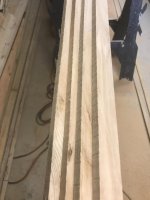DC ... you don't need a "guide", just a piece of angle iron like this:
View attachment dTQkX1H_3LNbGhhw0NXGkF_2R9UARoKA95rMvse2XSpczuAPZcfvjP2twjD3jNWo5n9j9CzjOK86SNtGp1lsvtR4BlCYp4kTbWaK
Jim has posted about making strips with just a skilsaw quite a few times, even has a short video (although not up to your quality, sry JIM). You can move the canoe off the strongback and set that up as your ripping table (I have pics of that in my current build) and save setting up a new one.
It isn't just for making strips though, any long length cuts, like your gunnels are very easy to do this way. Make the angle iron about the length of the saw and from 1/2" or 3/4" on a side, clamp it to your saw and instant guide. Sit the saw on the board and it will follow any bend or twist and give the same dimension through the entire cut. I cut some strips from a skarfed 20' piece of white cedar, with a bow of about 20" and it cut perfect, the strips are flexible so once cut, they stay straight.
You can still cut 3/4" gunnels, I am just saying that by the time you finish you will have a gunnel top that is over 2" wide, that is a lot of wood just for a gunnel IMO. Regardless of whether you reduce the gunnel dimensions, once you get them cut, the warp/bow can be oriented to work in your favour to better follow the sheer (it isn't straight either). and if you make the gunnels a little thinner, they will also be more flexible. So I suspect the board may seem bad, but it shouldn't be much of a problem.
If you go to say 1/2" and worry about hanging the seats, just add a 1/4" strip at the seat hanging point and taper it down at both ends. Gives you the real estate to hang the seats, treat the piece as a feature and you save a lot of ounces on the rest of the gunnel.
This is a pic from my Freedom 17 build, if you look at the seat area, you can see what I mean (gunnels were 3/8" btw)
View attachment I7zkTHyHMkE2YOQaAq_EXFqB8Z3M1fkFCvtvtUe5sMYSeGioea8wmiAhV9PyM-Qxei1bOltNqtYh5K0yJLXpXlQhqv-OVqkRwOU1
Just to get a feel for the material, maybe make up a few test slats (just a couple feet long), I just finished doing quite a bit of work with ash, and it is a very strong, stiff wood. Bend the test slats a bit, get a feel for the wood, then base your decision on what you held in your hands and what your gut tells you ... advice can be offered, but it always needs to be taken cautiously and then applied as you feel best.
Brian
View attachment dTQkX1H_3LNbGhhw0NXGkF_2R9UARoKA95rMvse2XSpczuAPZcfvjP2twjD3jNWo5n9j9CzjOK86SNtGp1lsvtR4BlCYp4kTbWaK
Jim has posted about making strips with just a skilsaw quite a few times, even has a short video (although not up to your quality, sry JIM). You can move the canoe off the strongback and set that up as your ripping table (I have pics of that in my current build) and save setting up a new one.
It isn't just for making strips though, any long length cuts, like your gunnels are very easy to do this way. Make the angle iron about the length of the saw and from 1/2" or 3/4" on a side, clamp it to your saw and instant guide. Sit the saw on the board and it will follow any bend or twist and give the same dimension through the entire cut. I cut some strips from a skarfed 20' piece of white cedar, with a bow of about 20" and it cut perfect, the strips are flexible so once cut, they stay straight.
You can still cut 3/4" gunnels, I am just saying that by the time you finish you will have a gunnel top that is over 2" wide, that is a lot of wood just for a gunnel IMO. Regardless of whether you reduce the gunnel dimensions, once you get them cut, the warp/bow can be oriented to work in your favour to better follow the sheer (it isn't straight either). and if you make the gunnels a little thinner, they will also be more flexible. So I suspect the board may seem bad, but it shouldn't be much of a problem.
If you go to say 1/2" and worry about hanging the seats, just add a 1/4" strip at the seat hanging point and taper it down at both ends. Gives you the real estate to hang the seats, treat the piece as a feature and you save a lot of ounces on the rest of the gunnel.
This is a pic from my Freedom 17 build, if you look at the seat area, you can see what I mean (gunnels were 3/8" btw)
View attachment I7zkTHyHMkE2YOQaAq_EXFqB8Z3M1fkFCvtvtUe5sMYSeGioea8wmiAhV9PyM-Qxei1bOltNqtYh5K0yJLXpXlQhqv-OVqkRwOU1
Just to get a feel for the material, maybe make up a few test slats (just a couple feet long), I just finished doing quite a bit of work with ash, and it is a very strong, stiff wood. Bend the test slats a bit, get a feel for the wood, then base your decision on what you held in your hands and what your gut tells you ... advice can be offered, but it always needs to be taken cautiously and then applied as you feel best.
Brian







